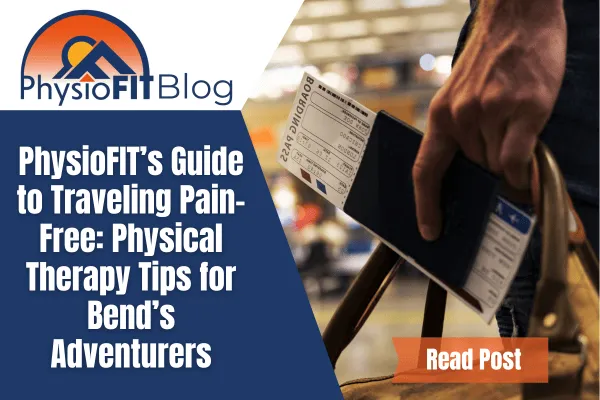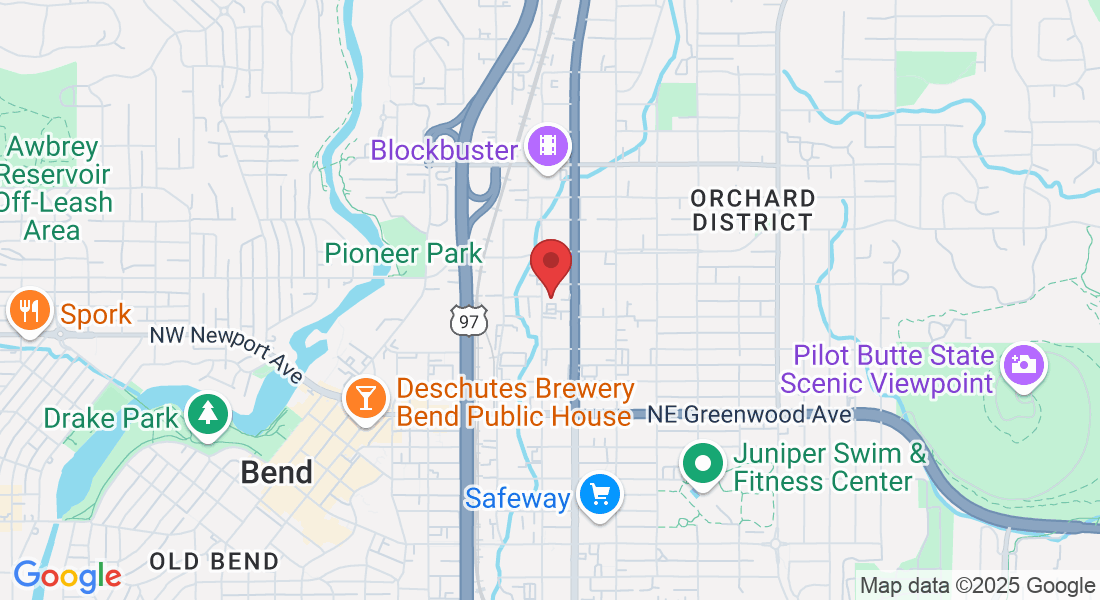Your Source for All Things Physical Therapy in Bend Oregon
The PhysioBLOG
Here, we share informative articles and insights that aim to help you achieve your full potential through our fitness-focused approach to rehabilitation. Our team is dedicated to providing you with valuable tips and techniques that can help you overcome any obstacle, whether you're recovering from an injury, surgery, or striving to build strength and wellness for life.
Stay up-to-date with our latest posts & empower yourself with elegantly simple techniques for optimal health & wellness.

PhysioFIT’s Guide to Traveling Pain-Free: Physical Therapy Tips for Bend’s Adventurers
Please Note: The information provided on our website is intended for general education and is not a substitute for professional medical advice. Each individual's situation and body are different. Therefore, what may work for one person may not work for another. We care about your well-being and advise you to reach out to us to discuss your specific needs before implementing any advice from our website. If you’d like to explore this more or would like to schedule a time with a physical therapist in Bend Oregon, contact us at PhysioFITBend.com
Introduction
PhysioFIT presents a comprehensive guide for travelers seeking to avoid pain. Learn how to travel pain-free with tips from our experts. Discover the techniques and strategies that will ensure a comfortable and enjoyable journey.
Packing Tips for Travelers
When it comes to traveling pain-free, proper packing plays a crucial role. In this guide, we'll share some invaluable tips to ensure a comfortable and pain-free travel experience.
One key aspect to consider is choosing the right suitcase. It's essential to select a suitcase that suits your travel needs and provides adequate support for your belongings. By understanding the importance of suitcase selection, you can make informed choices and alleviate any potential strain and discomfort while on the move.
Choosing the Right Suitcase
When it comes to selecting the appropriate baggage for your journey, opt for a suitcase that suits your needs. Consider various factors such as size, weight, durability, and maneuverability.
Suitcase size should be suitable for the duration of your trip and the amount of belongings you plan to bring.
Weight is an important consideration, as a heavier suitcase can be burdensome to carry and potentially exceed airline weight restrictions.
Durability is crucial to ensure that your belongings are protected during transit, especially if you are traveling long distances or encountering rough handling.
Maneuverability refers to the ease of moving your suitcase around. Features such as wheels and handles play a crucial role in making transportation more convenient.
Additionally, keep in mind other specific requirements you may have, such as whether the suitcase has compartments for organization or if it meets carry-on regulations. By carefully considering these factors, you can make an informed decision when choosing the right suitcase for your travels.
A unique detail worth mentioning is that some suitcases come with innovative features like built-in chargers or GPS tracking devices. These additional functionalities can provide extra convenience and security during your journey.
Taking Care of Your Body During Travel
When it comes to traveling, taking care of your body is crucial to ensure a pain-free journey. In this section, we will explore two essential aspects that contribute to keeping your body in good shape while you're on the go.
First, we will delve into the importance of staying active during your travels and how it can benefit your overall well-being.
Additionally, we’ll discuss the significance of supporting your body with good shoes, offering practical tips to help prevent common foot and leg issues.
So, let's dive in and learn how to maintain a healthy body while exploring new destinations.
Staying Active
To stay active during your travels, it's important to keep your body moving and engaged. Engage in physical activities that keep your muscles and joints active and flexible. This will help prevent stiffness, muscle fatigue, and potential injuries that can occur from prolonged periods of sitting or inactivity. Remember to prioritize movement throughout your journey to ensure a pain-free and enjoyable travel experience.
Find opportunities to stretch or move whenever possible, whether it's during layovers or while waiting for transportation. Take short walks, do some light stretching exercises, or try simple movements like shoulder rolls or ankle flexes. Keeping your body in motion will help improve circulation, reduce muscle tension, and alleviate any discomfort caused by prolonged sitting.
In addition to these activities, consider incorporating strength training exercises into your routine. This will help build muscle strength and endurance, which are essential for maintaining good posture and preventing muscular imbalances. You can do bodyweight exercises such as squats or lunges, or use resistance bands for added resistance.
Lastly, don't forget the importance of proper hydration and nutrition when staying active during travel. Drink plenty of water to stay hydrated and choose nutritious snacks that provide sustained energy throughout the day.
By staying active during your travels, you can maintain a healthy body and mind while enjoying all the adventures that await you. Embrace opportunities for movement and make it a priority to incorporate physical activity into your travel plans.
Supporting Your Body with Good Shoes
Wearing the right shoes plays a crucial role in supporting your body while traveling. Here are 5 key points to consider when supporting your body with good shoes:
Choose shoes that provide adequate arch support to maintain proper alignment of your feet and minimize strain on the rest of your body.
Opt for shoes with cushioning to absorb shock and reduce impact on joints, helping to prevent injuries and discomfort.
Select shoes made from breathable materials to keep your feet dry and comfortable during long hours of travel.
Look for shoes that offer a secure fit, providing stability and reducing the risk of slips or falls.
Consider packing orthotic inserts if you have specific foot conditions or require additional support.
It’s important to note that supportive footwear is not only beneficial during travel but also in everyday life. Properly supporting your body with good shoes can help alleviate pain, prevent injuries, and promote overall well-being.
Stretching Exercises for Travelers
As a travel enthusiast, I understand the importance of staying pain-free while exploring new destinations. In this part of PhysioFIT’s Guide to Traveling Pain-Free, we will explore a series of stretching exercises specifically designed for travelers like us. These exercises target different areas of the body to alleviate common travel-related discomforts such as neck and upper shoulder pain, headaches, and lower back stiffness. We will also learn how to improve overall mobility and flexibility, focusing on areas like the chest, armpits, and hamstrings. So, let's dive into these stretches and enhance our journey with comfort and ease.
Relieving Neck and Upper Shoulder Pain
Relieving Tension in the Neck and Upper Shoulder Area
Start by employing these four easy steps to relieve tension in the neck and upper shoulder area:
Perform gentle stretching exercises that target these specific areas.
Use heat therapy to relax the muscles.
Practice good posture throughout the day to alleviate strain.
Consider seeking professional help from a physical therapist for targeted treatment options.
In addition to these practical tips, it is important to note that maintaining a regular stretching routine can help prevent future episodes of neck and upper shoulder pain. By incorporating these stretches into your daily routine, you can improve flexibility and reduce the likelihood of experiencing discomfort in this area. It is recommended to consult with a healthcare professional for personalized guidance.
Historically, neck and upper shoulder pain have been common issues faced by individuals who engage in repetitive activities or spend prolonged periods in poor posture positions. As awareness grows about the importance of proper body mechanics and self-care practices, more people are taking proactive steps to alleviate and prevent discomfort in this area. Physical therapists continue to play a crucial role in guiding individuals towards effective pain management strategies for relieving neck and upper shoulder pain.
Relieving Headaches and Neck Pain
There are effective ways to alleviate headaches and neck pain while traveling. One method is engaging in stretching exercises specifically targeting the neck and upper shoulder area. These stretches can help relieve tension and improve flexibility in these areas, ultimately reducing pain.
Additionally, wearing supportive shoes during travel can provide extra cushioning and stability for the body, thereby minimizing strain on the neck and reducing the likelihood of headaches. By incorporating these strategies into your travel routine, you can alleviate headaches and neck pain for a more comfortable journey.
Improving Mobility in the Lower Back
Improving mobility in the lower back can be achieved through specific exercises and stretches that target the muscles and ligaments in this area. By incorporating these exercises into your routine, you can increase flexibility, reduce pain, and improve your overall spinal health.
Start with gentle stretching exercises to warm up the muscles in your lower back.
Engage in low-impact activities such as walking or swimming to strengthen the muscles around your spine.
Incorporate core-strengthening exercises like planks and bridges to provide stability and support for your lower back.
Practice proper posture and body mechanics throughout the day to prevent unnecessary strain on your lower back.
To further enhance your mobility in the lower back, consider seeking professional guidance from a physical therapist or chiropractor who can provide personalized recommendations based on your specific needs. They can help identify any underlying issues or imbalances that may be contributing to your pain or limited mobility.
By taking proactive steps to improve mobility in the lower back, you can reduce the risk of injury, alleviate discomfort, and enjoy a more active and pain-free lifestyle.
Stretching the Hamstrings
To improve flexibility and prevent injuries, it is important to focus on stretching the muscles in the back of the thigh known as the hamstrings. Follow these steps for an effective hamstring stretch:
Stand upright with one leg extended forward and the other leg positioned slightly behind you.
Keep your back straight and slowly bend forward from your hips, reaching towards your toes with both hands.
Hold this position for 20-30 seconds, feeling a gentle stretch in the back of your thigh.
While performing this stretch, remember to breathe deeply and avoid bouncing or jerking movements that can strain the muscles. It is recommended to repeat this stretch several times on each leg.
To maximize the benefits of stretching the hamstrings, ensure proper form and technique to avoid injury. Remember to consult a healthcare professional if you experience any pain or discomfort while performing these exercises.
Feel confident in taking care of your body during travel by incorporating hamstring stretches into your routine. Don't miss out on enhancing your mobility and preventing muscle tightness by neglecting this important exercise.
Conclusion
Traveling is an exhilarating experience, offering a chance to explore new horizons and create lasting memories. However, the physical demands of travel can sometimes take a toll on our bodies. From the strain of carrying luggage to the prolonged periods of sitting, it's essential to prioritize our well-being during our journeys.
The key to a pain-free travel experience lies in preparation and awareness. Investing in the right suitcase, understanding its significance, and knowing how to pack efficiently can make a world of difference. But beyond our luggage, it's our body that needs the utmost care. Staying active, wearing the right shoes, and incorporating regular stretches can alleviate common travel-related discomforts.
PhysioFIT's comprehensive guide underscores the importance of understanding our body's needs while traveling. From the nuances of choosing the right suitcase to the significance of stretching exercises tailored for travelers, the guide offers a holistic approach to traveling pain-free. The emphasis on the physical and mental aspects of travel ensures that travelers are equipped with the knowledge and tools to navigate their journeys with ease and comfort.
In essence, traveling doesn't have to be synonymous with discomfort. With the right strategies, guidance from experts like PhysioFIT, and a proactive approach, you can ensure that your travels are not only memorable but also comfortable. So, as you pack your bags for your next adventure, remember to also pack in the wisdom from this guide. Prioritize your well-being, embrace the stretches, and let every journey be a testament to traveling pain-free. Safe travels!
Five Facts For Traveling Pain-Free
✅ Over-packing can lead to a heavier suitcase, increasing the risk of injury during travel.
✅ Using smaller suitcases can help distribute the load and make lifting easier, especially when traveling by car.
✅ Packing supportive shoes can help prevent aches and pains associated with increased activity during travel.
✅ Regular movement is essential to prevent stiffness and promote blood flow during travel. Take breaks to stretch and walk around.
✅ Performing simple stretches for the neck, shoulders, chest, low back, and legs can help alleviate pain and discomfort during travel.
Please Note: It's important to note that any exercises or techniques that are shared should be performed under the guidance of a qualified bend physical therapy expert to ensure correct technique and to prevent injuries. A physical therapist can provide a customized exercise program based on the individual's fitness level, goals, and any existing injuries or conditions. If you’d like to explore this more or would like to schedule a time with a physical therapist in Bend Oregon, contact us atPhysioFITBend.com
Ask The Experts

PT, MSPT, OCS, CF-L1

PT, DPT, TPI, CF-L1

PT, DPT, CSCS
Copyright PhysioFIT 2025 . All Rights Reserved


